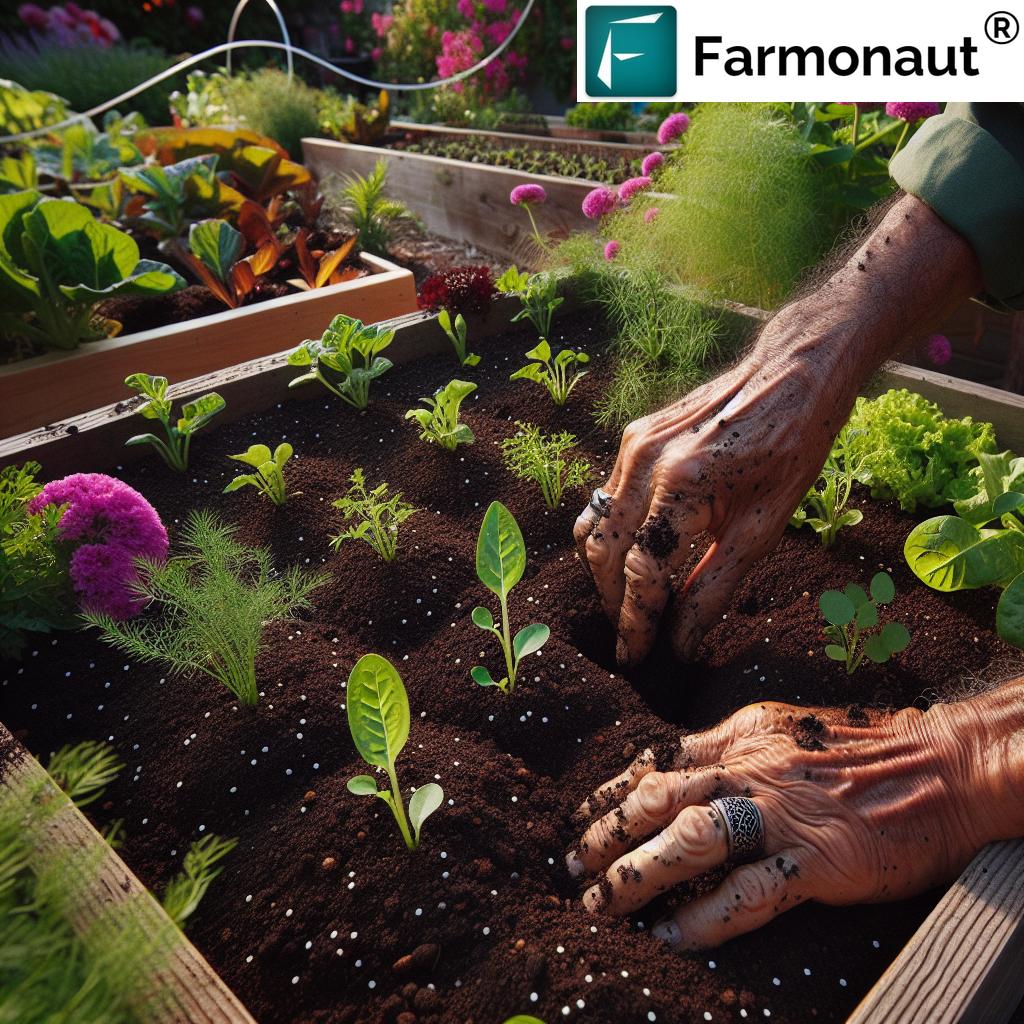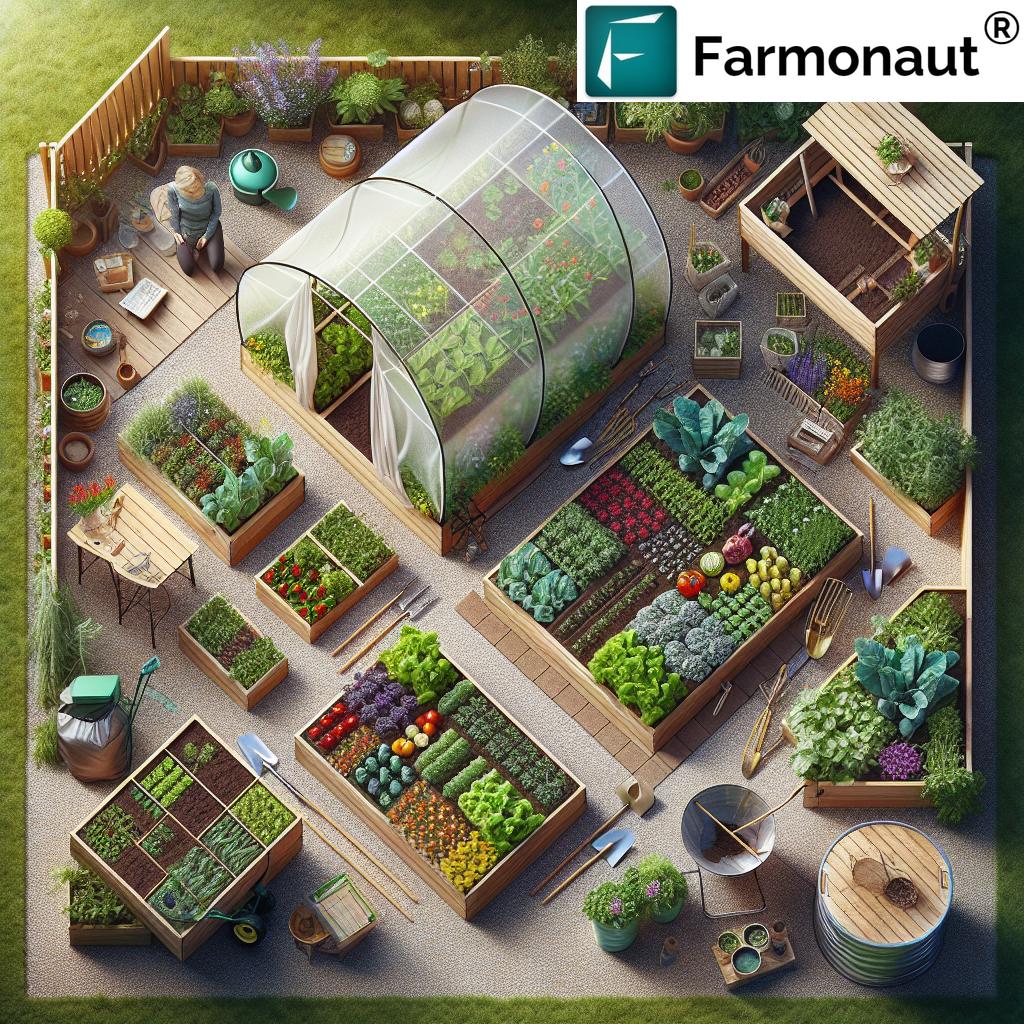Maximize Your Garden’s Potential: 10 Sustainable Raised Bed Techniques for Nutrient-Rich Soil and Bountiful Harvests

“Raised bed gardens can increase yields by up to 4 times compared to traditional in-ground gardens.”
Welcome to our comprehensive guide on maximizing your garden’s potential through sustainable raised bed techniques! In this article, we’ll explore ten innovative methods to create nutrient-rich soil and achieve bountiful harvests. Whether you’re a seasoned gardener or just starting, these strategies will help you transform your raised beds into thriving ecosystems.
At Farmonaut, we’re committed to making precision agriculture accessible to all. While our satellite-based crop health monitoring and AI advisory systems cater to larger farms, the principles of sustainable gardening apply to spaces of all sizes. Let’s dive into the world of raised bed gardening and discover how you can cultivate a flourishing garden right in your backyard!
1. Custom Soil Mixtures: The Foundation of Successful Raised Beds
The key to raised bed gardening benefits lies in creating the perfect soil environment for your plants. Unlike traditional in-ground gardens, raised beds give you complete control over your soil composition. Here’s how to craft the ideal mixture:
- Compost: Aim for about 30-40% of your mix to be high-quality compost. This organic matter is rich in nutrients and beneficial microorganisms.
- Topsoil: Use 30-40% topsoil to provide a stable base for your plants.
- Aeration materials: Add 20-30% of materials like perlite, vermiculite, or coarse sand to improve drainage and aeration.
- Organic amendments: Incorporate 5-10% of materials like worm castings, kelp meal, or bone meal for additional nutrients.
This custom blend ensures excellent soil quality improvement, promoting healthy root growth and nutrient uptake. Remember, the exact ratios may vary depending on your specific plants and local climate conditions.
2. Intensive Planting Methods: Maximizing Space and Yields
Raised beds are perfect for intensive planting methods, allowing you to grow more in less space. Here are some techniques to try:
- Square foot gardening: Divide your bed into 1-foot squares and plant a specific number of plants in each square based on their size.
- Vertical gardening: Use trellises, cages, or stakes to grow vining plants upward, saving ground space.
- Companion planting: Group plants that benefit each other, such as planting basil near tomatoes to repel pests.
- Succession planting: As one crop finishes, immediately replant with another to keep your bed productive year-round.
These intensive planting methods not only maximize garden yields but also help suppress weeds and conserve water. It’s a win-win for both your harvest and the environment!
3. Organic Mulching: Retaining Moisture and Suppressing Weeds
Mulching is a crucial organic gardening tip that offers multiple benefits for your raised beds:
- Moisture retention: A 2-3 inch layer of organic mulch can reduce water evaporation by up to 70%.
- Weed suppression: Mulch blocks sunlight, preventing weed seeds from germinating.
- Temperature regulation: It insulates the soil, keeping it cooler in summer and warmer in winter.
- Nutrient addition: As organic mulches break down, they enrich the soil with nutrients.
Great organic mulch options include straw, leaves, grass clippings, or wood chips. Apply mulch after planting and replenish as needed throughout the growing season.
4. Crop Rotation: Maintaining Soil Health and Preventing Pests
Crop rotation is a fundamental sustainable agriculture practice that’s easily implemented in raised beds. By changing the location of plant families each season, you can:
- Prevent soil depletion: Different crops use different nutrients, allowing the soil to recover.
- Reduce pest and disease problems: Many pests and pathogens are specific to certain plant families.
- Improve soil structure: Alternating between deep-rooted and shallow-rooted plants helps maintain good soil tilth.
A simple 4-year rotation might look like this: Year 1: Leafy greens, Year 2: Legumes, Year 3: Fruiting vegetables, Year 4: Root crops. Adjust based on your specific crops and garden size.
“Intensive planting in raised beds can reduce water usage by 30% while increasing crop production.”
5. Season Extension Techniques: Grow More, Longer
One of the significant advantages of raised bed gardening is the ability to extend your growing season. Here are some techniques to try:
- Cold frames: Build a simple wooden frame with a clear plastic or glass top to create a mini-greenhouse effect.
- Hoop houses: Create a tunnel over your bed using PVC pipes and cover with plastic sheeting.
- Row covers: Use lightweight fabric directly over plants for frost protection.
- Thermal mass: Place dark-colored stones or water-filled containers in your bed to absorb heat during the day and release it at night.
These extended growing season techniques allow you to start planting earlier in spring and continue harvesting later into fall or even winter, depending on your climate.
6. Water Management: Efficient Irrigation for Raised Beds
Proper water management in gardens is crucial for plant health and resource conservation. Raised beds offer excellent drainage, but they may also dry out faster than in-ground gardens. Here are some strategies for efficient watering:
- Drip irrigation: Install a drip system to deliver water directly to plant roots, reducing evaporation.
- Self-watering systems: Create a reservoir at the bottom of your bed for consistent moisture.
- Rainwater harvesting: Collect rainwater from your roof to use in dry periods.
- Moisture meters: Use these tools to accurately gauge when your plants need water.
Remember, most plants prefer deep, infrequent watering over frequent shallow watering. This encourages deeper root growth and improved drought resistance.
Explore Farmonaut’s API for advanced agricultural insights
7. Soil Testing and Amendment: Balancing Nutrients for Optimal Growth
Regular soil testing is essential for maintaining nutrient-rich soil mixtures. Here’s how to approach soil testing and amendment:
- Test your soil annually to check pH levels and nutrient content.
- Adjust pH using lime (to raise) or sulfur (to lower) as needed. Most vegetables prefer a slightly acidic soil with a pH between 6.0 and 7.0.
- Add organic matter like compost or well-rotted manure to improve overall soil structure and fertility.
- Use natural amendments to address specific nutrient deficiencies:
- Nitrogen: Blood meal or alfalfa meal
- Phosphorus: Bone meal or rock phosphate
- Potassium: Wood ash or greensand
By regularly testing and amending your soil, you ensure that your plants have access to all the nutrients they need for healthy growth and bountiful harvests.
8. Composting: Creating Your Own Nutrient Powerhouse
Composting is a cornerstone of sustainable gardening practices. By creating your own compost, you can:
- Recycle kitchen and garden waste into valuable soil amendments
- Improve soil structure and water retention
- Provide a slow-release source of nutrients for your plants
- Encourage beneficial microorganisms in your soil
To start composting, layer “green” materials (nitrogen-rich, like kitchen scraps and grass clippings) with “brown” materials (carbon-rich, like dry leaves and straw). Keep the pile moist and turn it regularly to aerate. In a few months, you’ll have rich, dark compost to add to your raised beds.
Check out our API Developer Docs for integration details
9. Pest Management: Natural Solutions for a Healthy Garden
Raised beds can help reduce pest problems, but you may still encounter some uninvited guests. Here are some organic pest management strategies:
- Companion planting: Intersperse pest-repelling plants like marigolds or nasturtiums throughout your beds.
- Handpicking: Regularly inspect your plants and remove pests by hand when populations are low.
- Beneficial insects: Encourage natural predators like ladybugs and lacewings by planting flowers they love.
- Organic sprays: Use neem oil, insecticidal soaps, or homemade garlic sprays for more persistent problems.
- Physical barriers: Use row covers or netting to protect plants from flying insects and birds.
Remember, a healthy, diverse garden is naturally more resistant to pests. Focus on building soil health and plant diversity to create a balanced ecosystem in your raised beds.
10. Cover Cropping: Nurturing Your Soil During Off-Seasons
Cover cropping is an excellent way to maintain and improve your soil during periods when you’re not actively growing food crops. Benefits include:
- Preventing soil erosion
- Suppressing weeds
- Adding organic matter to the soil
- Fixing nitrogen (with leguminous cover crops)
- Breaking pest and disease cycles
Popular cover crops for raised beds include clover, buckwheat, and winter rye. Plant them in late summer or early fall, then turn them into the soil a few weeks before your spring planting.

Comparison of Raised Bed Soil Mixtures
| Soil Mixture Components | Benefits | Ideal Crops | Estimated Yield Increase |
|---|---|---|---|
| Compost + Topsoil + Perlite | Excellent drainage, nutrient-rich | Tomatoes, Peppers, Eggplants | 20-30% |
| Worm Castings + Coconut Coir + Vermiculite | High water retention, aeration | Leafy Greens, Herbs | 15-25% |
| Leaf Mold + Garden Soil + Sand | Good for root development, improved structure | Root Vegetables, Carrots, Beets | 10-20% |
Conclusion: Embracing Sustainable Raised Bed Gardening
By implementing these ten sustainable raised bed techniques, you’re not just maximizing your garden’s potential – you’re contributing to a more sustainable and productive approach to home gardening. From creating nutrient-rich soil mixtures to employing smart water management strategies, each technique plays a crucial role in cultivating a thriving garden ecosystem.
Remember, gardening is a journey of continuous learning and adaptation. Don’t be afraid to experiment and find what works best in your unique environment. With patience, care, and these sustainable practices, you’ll be well on your way to enjoying bountiful harvests and a flourishing garden year after year.
While Farmonaut’s advanced satellite-based farm management solutions are designed for larger agricultural operations, the principles of sustainable and efficient gardening apply to spaces of all sizes. By embracing these techniques in your raised beds, you’re participating in the broader movement towards more sustainable and productive agriculture practices.
FAQs
- Q: How deep should a raised bed be for optimal plant growth?
A: Most raised beds should be at least 6-12 inches deep. However, for root vegetables or plants with deeper root systems, a depth of 18-24 inches is ideal. - Q: Can I use treated lumber to build my raised beds?
A: It’s best to avoid pressure-treated lumber for food gardens. Instead, use naturally rot-resistant woods like cedar or redwood, or materials like stone or concrete blocks. - Q: How often should I fertilize my raised bed garden?
A: It depends on your soil and plants, but generally, apply a balanced organic fertilizer once at planting time and again mid-season for heavy feeders. Always follow package instructions and avoid over-fertilizing. - Q: Can I plant trees or shrubs in raised beds?
A: While raised beds are typically used for vegetables and annuals, you can grow small trees and shrubs in larger, deeper raised beds. Ensure the bed is at least 24 inches deep and wide enough to accommodate the plant’s mature size. - Q: How do I prevent my raised beds from drying out too quickly?
A: Use mulch to retain moisture, install drip irrigation systems, and consider adding water-retentive materials like coconut coir to your soil mix. Regular deep watering also encourages deeper root growth, improving drought resistance.



